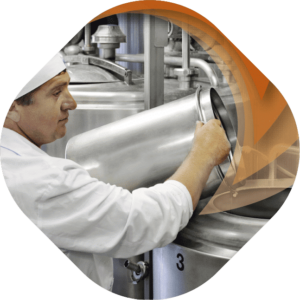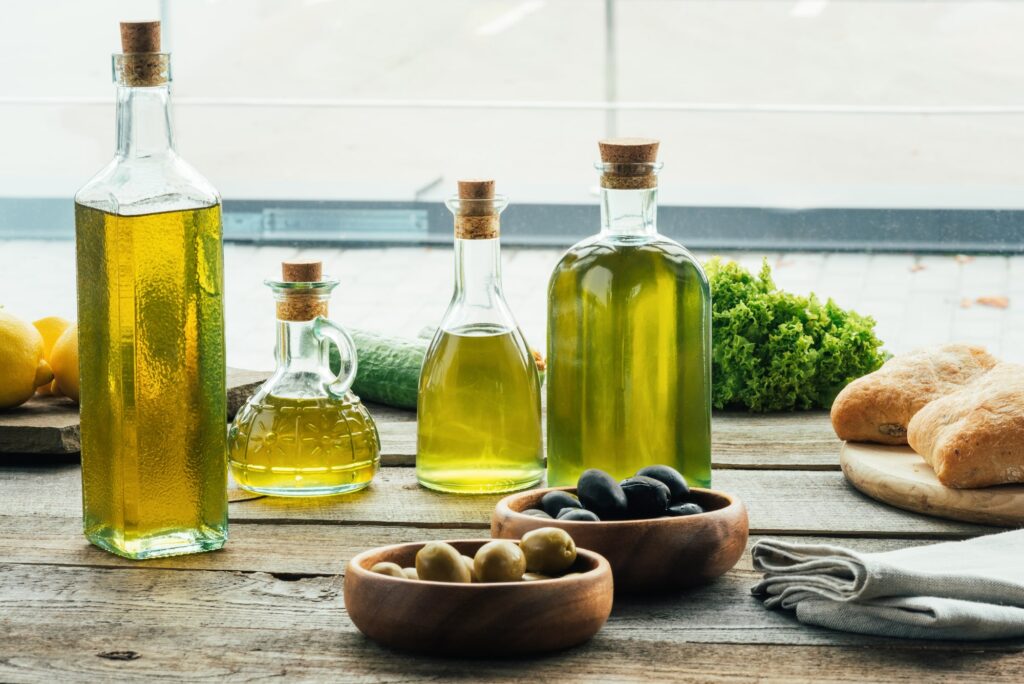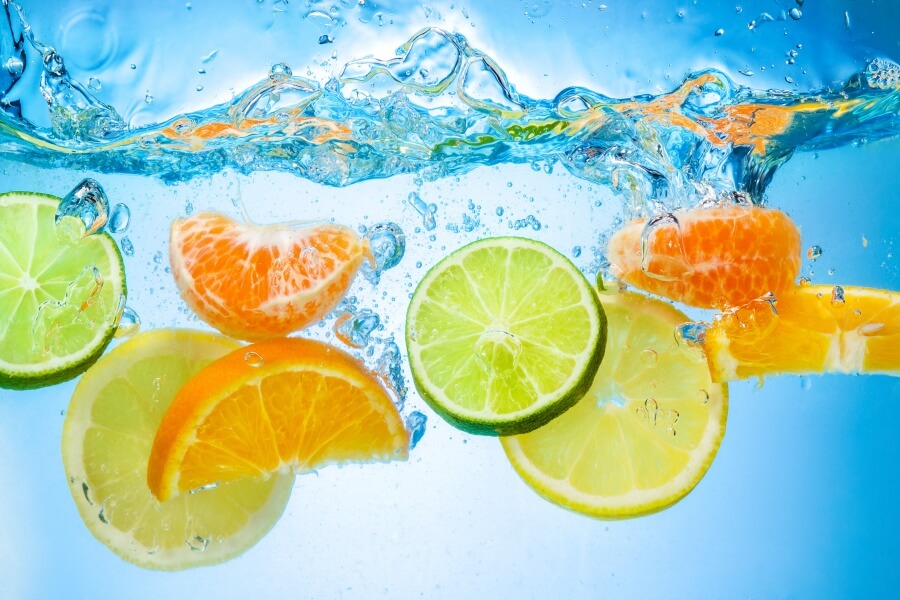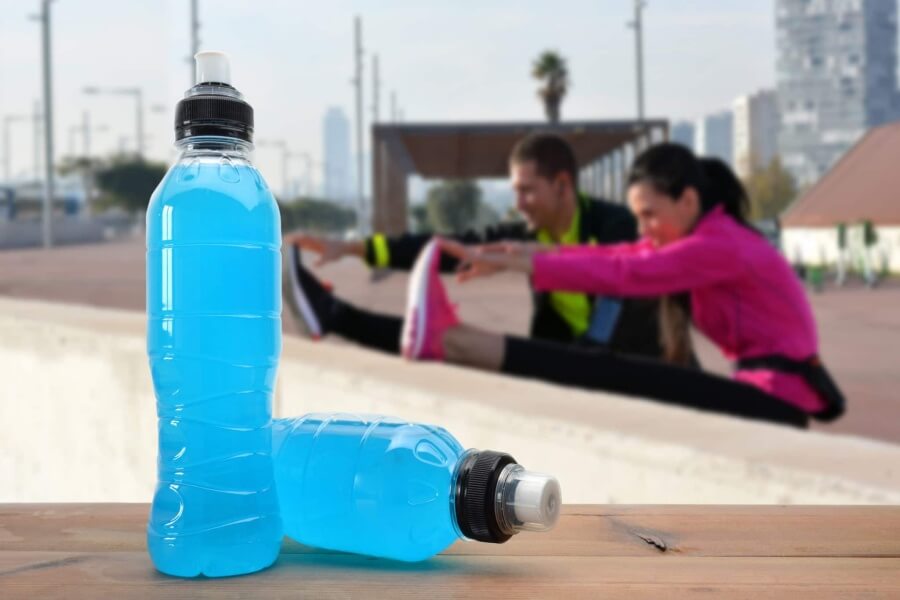
Edible Oil
Oils and fats are an essential part of the modern diet and have been used for food preparation for a very long time. It is a rich source of food energy and contain more than twice the caloric value equivalent to the amount of carbohydrates. The function of oils and fats not only adds flavor to the food, but also increases its nutritional value and unsaturated fatty acids.

For the best mixing solution we rely on our process knowledge of more than 80 years and our high quality sanitary design

Edible oils are made up of building blocks also called triglycerides. Those building blocks are formed from the combination of one unit of glycerol and three units of fatty acids. They are soluble in water but are also often soluble in most organic solvents. Oils have a lower density than water and edible oil at a low temperature can have solid, semi-solid or clear liquid. Oil at room temperature is also often referred to as the type of fat.
Different forms of edible oil
There are vastly different types of edible oil, from vegetable oils to animal oils. Some of the main types of oil are:
- Corn oil
Oil is extracted from corn germs. Corn oil is mainly used for cooking, this is because corn oil is a neutral oil. Partly because of this neutral oil and the high boiling point that corn oil possesses, it is an excellent agent to use as a frying agent, for example. - Crude palm oil
Crude palm oil is a vegetable oil. This light oil is made from the palm oil fruit and is mainly used as an oil for cooking. It is a rich medium with a light yellow oil color. The oil is often used as a compound of oils to make products extra saturated, for example. - Rapeseed oil
Rapeseed is one of the largest sources for oil. Rapeseed oil often gives a fragrant taste but also a powerful flavor to dishes. In addition, rapeseed oil can be used as a cold oil but also as a reheated oil.
Market development of edible oil
The global edible oil market size was 186.55 billion in 2020. It is expected to grow to 204.74 billion euros by 2021 to as much as 291.72 billion euros by 2028. Yet, in addition to these fine growth figures, there are some setbacks. Because of the war in Ukraine, there is a supply problem in wheat, corn and barley. As a result, the European Union, among others, can expect less supply. Furthermore, Indonesia, a palm oil rich country is struggling with a shortage of workers for the plantations. Because the country is also facing its own shortage, it has been decided that Indonesia will first use the palm oil itself before looking at how much oil is available for export.
Beverages Applications
Frequently Asked Questions
What are edible oils primarily made of?
Edible oils are made up of triglycerides, which consist of one glycerol unit combined with three fatty acids. These oils can be soluble in water and various organic solvents, and they exist in solid, semi-solid, or liquid forms depending on temperature.
What are the main types of edible oils?
The main types of edible oils include corn oil, crude palm oil, and rapeseed oil. Each has its unique characteristics and common uses in cooking, with corn oil being neutral, palm oil being light and rich, and rapeseed offering distinct flavors.
What is the process of refining edible oil?
The refining process typically involves degumming, bleaching, and deodorization. This is done to remove impurities, enhance color, and eliminate odors, usually involving methods such as steam distillation and the use of solvents.
What are the benefits of using vegetable oils?
Vegetable oils offer high energy content, enhance food flavor, and provide essential unsaturated fatty acids. They are important for maintaining a balanced diet and can also be used as frying agents due to their high boiling points.
Why has the edible oil market been affected recently?
The edible oil market faces challenges due to supply issues exacerbated by the war in Ukraine and labor shortages in countries like Indonesia, which heavily impact the availability of vital products like palm oil and other oils.
Food & Beverages Contacts

Tom Pruymboom
Sales Director

Teun van der Spek
Area Sales Manager

Sijko van der Veen
Application Engineer
Technical Specialist
Food & Beverages – Related Articles

Fermentation & Bioreactor Mixing Process
Bioreactors and Fermenters are culture systems to produce cells or organisms. They are used in various applications, including basic research and development, and the manufacturing of biopharmaceuticals, food and food additives, chemicals, and other products. A broad range of cell types and organisms can be cultivated in bioreactors and Fermenters, including cells (like mammalian cell lines, insect cells, and stem cells), microorganisms (like bacteria, yeasts, and fungi), as well as plant cells and algae. The words “Bioreactor” and “Fermenter” are basically the same thing.

How to avoid foaming in your mixing process?
Through years of experience, Jongia Mixing Technology knows the correct application to many mixing processes. So too with mixing processes where the elimination of foaming – which can occur through the behaviour of the recipe – is of great importance.

Tutorial: starch gelatinization – from raw starch to glucose syrup
Around the world, Jongia Mixing Technology has initiated numerous mixing processes using its agitators to produce modifications from raw starch and convert them into usable products. An example of a product where raw starch is one of the constituents is
Production process of edible oil
The production process of edible oil typically involves the removal of oil from plant components, such as for example corn, sunflower or rape seeds. This can be done via mechanical extraction using an oil mill or chemical extraction using a solvent. The extracted oil is then purified and, if required, refined or chemically altered. It is during the refinery process that Jongia mixers are in operation.
In large oil storage tanks side entry mixers, type JDRW/JRWM or RWM are used to keep the contents of the vessel homogeneous and to prevent sedimentation. In case of a high solids contents and an advanced degree of impurity of the oils top entry mixers may be necessary.
In particular during the degumming stage when solvents such as sodiumhydroxide (NaOH) solution and hydrochloric acid are used to remove soapstock and gums from the oil gentle treatment of the product is required. The Jongia L-type mixer is the mixer of choice especially in combination with pitch blade elements or hydrofoils.
Typically the solvents are added in-line either by means of a static mixer or an IM type high shear mixer. After the in-line mixers come the resident tanks where gentle mixing action….
The oil mill route
This option starts with the separation of the soybeans into two fractions: oil and meal. There are, basically,two process alternatives to achieve this purpose: pressing and solvent extraction. Each one of the fractions is then further processed to yield a multitude of products and by-products, with practically no waste. Since oil meal operations are often the starting point in the preparation of soybean protein products, they will be reviewed in some detail in Chapter 3. The processes and products associated with the oil fraction will be described here in some detail. Soybean protein products which branch-off from the meal fraction will be just mentioned here for the sake of completeness and taken up in detail in specific chapters to follow.
Utilization of the oil fraction:
a- Oil refining: The preparation of marketable soybean oil for human consumption from crude soybean oil requires a series of operations known as ” refining “. Several alternative technologies are available for each one of these operations. Each one can be carried out in batchwise, continuous or semi-continuous fashion.
The first step in refining crude soybean oil is the removal of the phospholipids, or “degumming“. Degumming is necessary in order to prevent the separation and settling of gums (sticky, viscous oil-water emulsions stabilized by the phospholipids) during transportation and storage of crude oil, to reduce oil losses in the subsequent phases of refining and to avoid excessive darkening of the oil in the course of high-temperature deodorization. Crude oil is mixed thoroughly with a small amount of water and an acid ( usually phosphoric acid ). “Gums” are formed and precipitated, carrying in the emulsion a certain amount of oil. They are separated by centrifugation, dried under vacuum and bleached. The resulting product consists approximately of 50% phospholipids and 50% oil and has the consistency of honey.
The phospholipid fraction may be separated from practically all the oil by a series of solvent extraction and precipitation processes. Oil free soybean phospholipids are solid. All these by-products of the degumming process are known as “soybean lecithin” and sold under different trade-names and in a variety of quality grades. The principal quality parameters for commercial lecithins are: phospholipid content ( measured as percent acetone insolubles ), free acidity, non-lipid impurities ( measured as hexane insolubles ), viscosity and colour. For certain applications requiring an extremely bland lecithin, the phospholipids are separated from the crude soybean oil fraction, purified and then redissolved in any desired type of refined oil. Lecithins are mainly used for their activity at the interface between fats and hydrophillic phases. They act as emulsifiers in sauces and salad dressings, as viscosity reducers and stabilizers in chocolate, as anti-spattering agents in margarine, as pan release agents in bakery and confectionery , as dough improvers and staling retardants in bread, as wetting agents in instant food powders etc. They also have some antioxidant property.
Degumming is usually carried out at the extraction plant, even if the subsequent steps of refining are performed elsewhere. Whenever further processing of the crude gums is not economically feasible, due to insufficient plant scale or insufficient market demand, the crude gums can be added-back to the meal, increasing the bulk and caloric value of the latter.
There are two major types of processes for refining degummed oil. They differ in the way the free fatty acids are removed. In the “chemical ” or “caustic” refining process,the most common process applied to soybean oil, the fatty acids are neutralized with alkali (sodium hydroxide and sodium carbonate ) to form salts ( soaps ) soluble in water. Treatment with caustic solutions also removes residues of phospholipids not removed by degumming and results in some degree of bleaching due to the destruction of some of the pigments or their adsorption by the heavy phase.
The resulting aqueous soap solution, known as “soap stock” is removed from the neutralized oil by centrifugation. The amount of alkali to be added is calculated according to the free fatty acid content of the oil plus a slight excess (about 0.1%).
Crude soybean oil contains typically 0.3 to 0.7% free fatty acids. After neutralization, the oil is thoroughly mixed with hot soft water to remove traces of soap (washing ), then centrifuged again and dried by heating under vacuum,in preparation to the next step, bleaching. Soap stock can be used for making soap or it can be converted back to fatty acids by treating with a strong mineral acid. The crude mixture of fatty acids obtained, known as “acidified soap stock” can be used as a caloric component in animal feed or for the manufacture of distilled fatty acids. In the “physical refining” process, less commonly applied to soybean oil, fatty acids are removed by steam distillation under high vacuum, simultaneously achieving deodorization. Oil for physical refining must be degummed more thoroughly than in the case of alkali refining process.
The next step of refining is “bleaching‘. Its purpose is to remove the yellow-orange carotenoid pigments and the green chlorophyll of the oil. The extent of bleaching depends on market requirements. The market in the U.S.A. requires almost water-clear appearance while somewhat darker colour may be perfectly acceptable or even preferred in other markets. Bleaching is carried out by treating the oil with solid adsorbents such as Fuller’s earth or activated carbon or both. The pigments and some other impurities are adsorbed on the solid surface and removed by filtration. In order to prevent oxidation, the process is carried out under vacuum. Continuous “in-flow” bleaching processes are available.
The last refining operation is “deodorization“. It consists in the removal of odorous substances by steam distillation under high vacuum and at temperatures in the range of 2500 C. Typically,the deodorizer is a vertical cylindrical vessel with internal baffles and other devices to ensure exposure of a large surface area of oil and intimate contact between the oil and steam. At the end of the stripping process, the oil must be cooled while still under vacuum to prevent oxidation. Citric acid is usually added in order to chelate any metal ions which may catalyze peroxide formation. In modern deodorizers, all the parts in contact with oil are made of stainless steel to prevent such metal contamination. While the main objective of deodorization is the removal of odour-bearing compounds such as aldehydes, ketones and hydrocarbons, other substances such as sterols and tocopherols are also distilled off. In physical refining, this operation is responsible for the removal of free fatty acids. All these substances may be recovered from the deodorizer condensate stream, if necessary.
b- Further processing and utilization of refined soybean oil: Freshly refined soybean oil is practically odourless and bland. However, objectionable off-flavour described as “green, grassy,fishy” is known to develop quickly if the oil is heated (as in cooking and frying), or stored under conditions which expose it to light and oxygen or permits contamination with certain metals such as copper and iron.
This type of flavour deterioration has been called “flavour reversion”, expressing the thought that it brings back the off-flavours of crude oil. Although this has been shown to be false, the term of “flavour reversion” is still used sometimes, when referring to the flavour deterioration of refined soybean oil. The process is apparently triggered by the oxidation of the unsaturated fatty acids and most particularly that of linolenic acid. Unlike oxidative rancidity, flavour reversion occurs at very low levels of oxidation and is not retarded appreciably by antioxidants. It can be retarded by minimizing exposure to oxygen ( bottling under nitrogen ) and to light ( opaque containers, dark glass bottles).
Another method of flavour stabilization is the reduction of the linolenic acid content by selective hydrogenation, followed by chilling ( winterization ) to remove the high melting point saturated fatty acids formed. The partially hydrogenated- winterized soybean oil is perfectly suitable as an all-purpose (salad and cooking) oil. The crystalline fraction separated after chilling is known as “soybean stearin” and used in different solidified fats.
More complete hydrogenation of soybean oil is the basis for the manufacture of shortenings, margarines and tailor-made fats used by various food industries.
Utilization of the meal fraction:
a- Soybean meal as animal feedstuff: By far the largest portion of the soybean oil meal and cake production is used as a protein source in animal feed. Although the terms “meal” and “cake” are often used interchangeably, meal refers to the product of solvent extraction, while cake is the product resulting from expeller pressing of soybeans. The different types of soybean meals are characterized mainly by their protein content and the extent of heat treatment applied in their production to inactivate anti-nutritional factors. If the soybeans are extracted without dehulling,or if the hulls are added back after extraction, the meal will contain about 44% protein. Meals produced from dehulled beans contains approximately 50% protein.
The extent of heat treatment or toasting is measured in terms of residual urease activity or as the solubility of the protein under
Oils can also be removed via mechanical extraction, termed “crushing” or “pressing”.
solvent extraction
The processing vegetable oil in commercial applications is commonly done by chemical extraction, using solvent extracts, which produces higher yields and is quicker and less expensive. The most common solvent is petroleum-derived hexane. This technique is used for most of the “newer” industrial oils such as soybean and corn oils.
Supercritical carbon dioxide can be used as a non-toxic alternative to other solvents.
Hydrogenation
Oils may be partially hydrogenated to produce various ingredient oils. Lightly hydrogenated oils have very similar physical characteristics to regular soy oil, but are more resistant to becoming rancid. Margarine oils need to be mostly solid at 32 °C (90 °F) so that the margarine does not melt in warm rooms, yet it needs to be completely liquid at 37 °C (98 °F), so that it doesn’t leave a “lardy” taste in the mouth.
Hardening vegetable oil is done by raising a blend of vegetable oil and a catalyst in near-vacuum to very high temperatures, and introducing hydrogen. This causes the carbon atoms of the oil to break double-bonds with other carbons, each carbon forming a new single-bond with a hydrogen atom. Adding these hydrogen atoms to the oil makes it more solid, raises the smoke point, and makes the oil more stable.
Hydrogenated vegetable oils differ in two major ways from other oils which are equally saturated. During hydrogenation, it is easier for hydrogen to come into contact with the fatty acids on the end of the triglyceride, and less easy for them to come into contact with the center fatty acid. This makes the resulting fat more brittle than a tropical oil; soy margarines are less “spreadable”[compared to?]. The other difference is that trans fatty acids (often called trans fat) are formed in the hydrogenation reactor, and may amount to as much as 40 percent by weight of a partially hydrogenated oil. Hydrogenated oils, especially partially hydrogenated oils with their higher amounts of trans fatty acids are increasingly thought to be unhealthy.
References: Cargill/Bunge/Azersun ADM/IOI Loders Croklaan



















